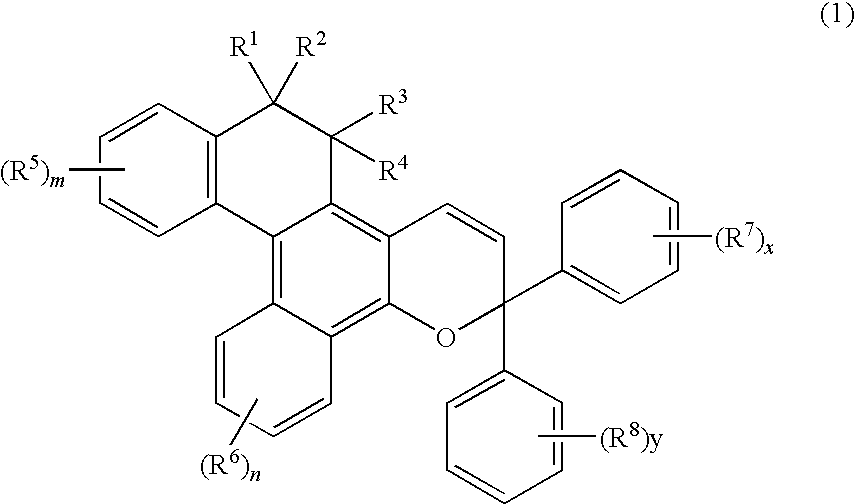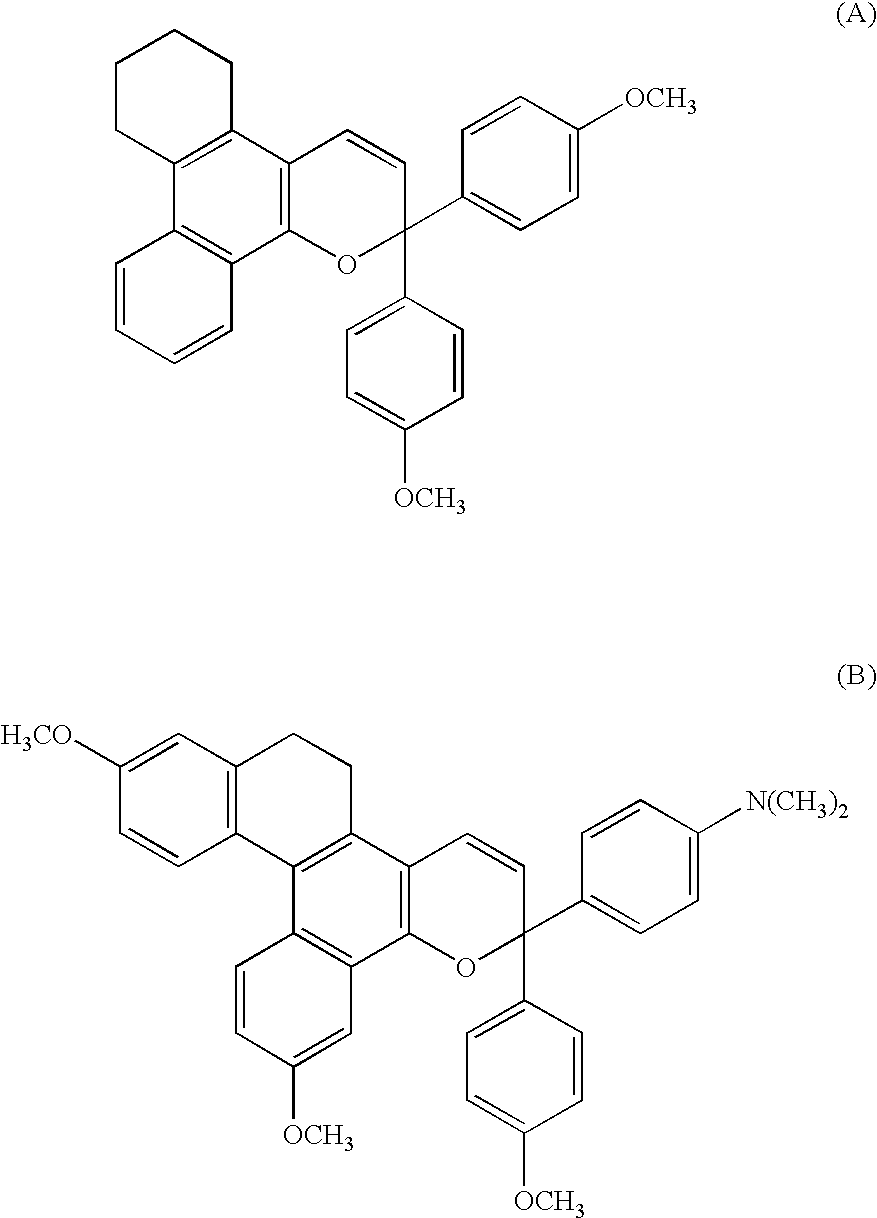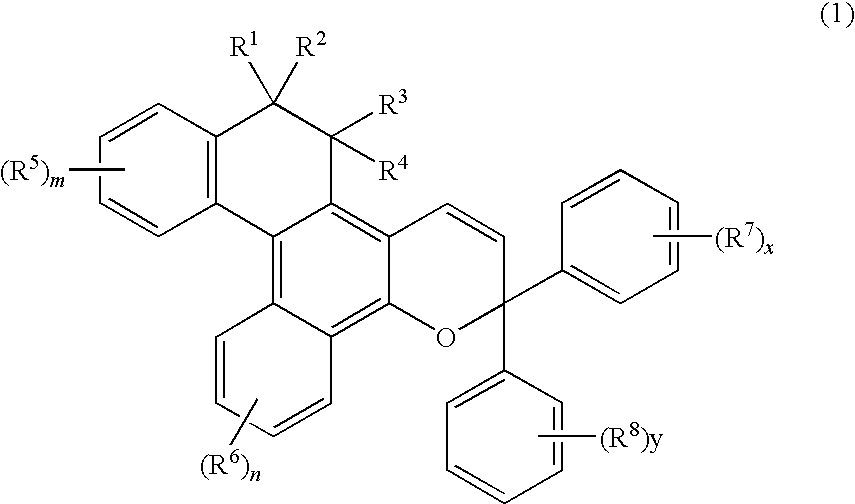Chromene compounds
a technology of chromium compounds and compounds, applied in the field of chromium compounds, can solve the problem of inability to obtain favorable photochromic coating layers,
- Summary
- Abstract
- Description
- Claims
- Application Information
AI Technical Summary
Benefits of technology
Problems solved by technology
Method used
Image
Examples
example 1
[0095]A naphthol derivative and a propargyl alcohol derivative expressed by the following formulas were used.
Naphthol Derivative:
[0096]
[0097]
[0098]6.3 Grams (20 mmols) of the naphthol derivative and 5.9 g (22 mmols) of the propargyl alcohol derivative were dissolved in 300 ml of toluene to which was further added 0.05 g of a p-toluenesulfonic acid, and the mixture was stirred for 30 minutes while being heated and refluxed. After the reaction, the solvent was removed and the reaction product was refined by chromatography on silica gel to obtain 3.5 g of a white powdery product.
[0099]The product presumed to be C40H36O3 was elementally analyzed and calculated to be as follows:
[0100]Elemental analysis: C, 85.23%, H, 6.38%, O: 8.39%
[0101]Calculated: C, 85.08%, H, 6.42%, O: 8.50%
[0102]Measurement of proton nuclear magnetic resonance spectra indicated a peak of 18H near δ 1.0 to 4.0 ppm based on alkylene group and a peak of 18H near near δ 5.2 to 10.0 ppm based...
examples 2 to 24
[0106]Chromene compounds shown in Tables 1 to 6 were synthesized in the same manner as in Example 1 by using compounds shown in Tables 1 to 6 as naphthol derivatives and propargyl alcohol derivatives. The obtained products were confirmed for their structures relying on the same structure analysis as that of Example 1.
[0107]In the structural formulas shown in Tables 1 to 6, Me represents the methyl group.
[0108]
TABLE 1Com-Ex.poundStaring materialYieldNo.No.Naphthol derivativePropagyl alcoholProduct(%)2225333044215518
[0109]
TABLE 2Com-Ex.poundStaring materialYieldNo.No.Naphthol derivativePropargyl alcoholProduct(%)6622771688189924
[0110]
TABLE 3Com-Ex.poundStaring materialYieldNo.No.Naphthol derivativePropargyl alcoholProduct(%)101018111117121230131328
[0111]
TABLE 4Com-Ex.poundStaring materialYieldNo.No.Naphthol derivativePropargyl alcoholProduct(%)141416151525161621171720
[0112]
TABLE 5Com-Ex.poundStaring materialYieldNo.No.Naphthol derivativePropargyl alcoholProduct(%)181824191921202019212...
example 25
[0114]A radically polymerizable monomer composition was prepared according to the following recipe.
Radically Polymerizable Monomer Composition:
[0115]
2,2-Bis(4-50 parts by massmethacryloyloxypentaethoxyphenyl)propanePolyethylene glycol diacrylate (average molecular10 parts by massweight, 532)Trimethylolpropane trimethacrylate10 parts by massPolyester oligomer hexaacrylate (EB-183010 parts by massmanufactured by Dycel UCB Co.)Glycidyl methacrylate10 parts by massChromene compound of Example 1 1 part by mass
[0116]As the photopolymerization initiator, further, CGI1800 manufactured by Chiba Specialty Chemicals Co. was provided. This photopolymerization initiator is a mixture of 1-hydroxycyclohexylphenyl ketone and a bis(2,6-dimethoxybenzoyl)-2,4,4-trimethyl-pentylphosphinoxide (weight ratio of 3:1).
[0117]By using the above radically polymerizable monomer composition and the photopolymerization initiator, a photopolymerizable and curable composition was prepared by homogeneously mixing th...
PUM
| Property | Measurement | Unit |
|---|---|---|
| thickness | aaaaa | aaaaa |
| thickness | aaaaa | aaaaa |
| temperature | aaaaa | aaaaa |
Abstract
Description
Claims
Application Information
 Login to View More
Login to View More - R&D
- Intellectual Property
- Life Sciences
- Materials
- Tech Scout
- Unparalleled Data Quality
- Higher Quality Content
- 60% Fewer Hallucinations
Browse by: Latest US Patents, China's latest patents, Technical Efficacy Thesaurus, Application Domain, Technology Topic, Popular Technical Reports.
© 2025 PatSnap. All rights reserved.Legal|Privacy policy|Modern Slavery Act Transparency Statement|Sitemap|About US| Contact US: help@patsnap.com



